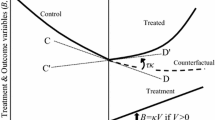Abstract
This paper considers the problem of estimating the bounds on the average controlled direct effects (ACDEs) of a treatment variable on an unobserved response variable in the presence of unobserved confounders between an intermediate variable and the response variable. When the response variable is observed, Cai, et al.(2008) derived the formulas for the sharp bounds on the ACDEs. When the response variable is unobserved, the authors propose a graphical criterion for selecting variables affected by the response variable to derive the formulas for the bounds on the ACDEs, which is an extension of the result of Kuroki(2005) to ACDEs. The results enable us not only to judge from the graph structure whether the bounds on the ACDEs can be expressed through observed variables when the response variable is unobserved, but also to provide their formulas when the answer is affirmative.
Similar content being viewed by others
References
R. L. Prentice, Surrogate endpoints in clinical trials: Definition and operational criteria, Statistics in Medicine, 1989, 8: 431–440.
M. Buyse and G. Molenberghs, Criteria for the validation of surrogate endpoints in randomized experiments, Biometrics, 1998, 54: 1014–1029.
W. Mu, S. Xiong, and X. Xu, Generalized confidence regions of fixed effects in the two-way ANOVA, Journal of Systems Science & Complexity, 2008, 21(2): 276–282.
H. Xie, G. Zou, and S. Wang, Price range volatility: A new indicator for risk measurement, Journal of Systems Science and Mathematical Sciences, 2009, 29: 1459–1465.
J. Pearl, Causal diagrams for empirical research (with discussion), Biometrika, 1995, 83: 669–710.
J. Pearl, Causality: Models, Reasoning, and Inference, Cambridge University Press, New York, 2000.
M. Kuroki and M. Miyakawa, Covariate selection for estimating the causal effect of control plans by using causal diagrams, Journal of the Royal Statistical Society Series B, 2003, 65: 209–222.
S. Kaufman, J. S. Kaufman, R. F. Maclenose, et al., Improved estimation of controlled direct effects in the presence of unmeasured confounding of intermediate variables, Statistics in Medicine, 2005, 24: 1683–1702.
Z. Cai, M. Kuroki, J. Pearl, and J. Tian, Bounds on direct effects in the presence of confounded intermediate variables, Biometrics, 2008, 64: 695–701.
M. Kuroki, Bounds on average causal effects in studies with a latent response variable, Metrika, 2005, 61: 63–71.
M. Kuroki, Graphical identifiability criteria for causal effects in studies with an unobserved treatment/ response variable, Biometrika, 2007, 94: 37–47.
J. Pearl, Probabilistic Reasoning in Intelligent Systems, Morgan Kaufmann, San Mateo, CA, 1988.
P. Spirtes, C. Glymour, and R. Scheines, Causation, Prediction, and Search, 2nd edition, MIT Press, 2000.
The Lipid Research Clinics Coronary Primary Prevention Trial Results, I. Reduction in incidence of coronary heart disease, Journal of the American Medical Association, 1984, 251: 351–364.
L. S. Freedman, B. I. Graubard, and A. Schatzkin, Statistical validation of intermediate endpoints for chronic diseases, Statistics in Medicine, 1992, 11: 167–178.
A. Balke and J. Pearl, Bounds on treatment effects from studies with imperfect compliance, Journal of the American Statistical Association, 1997, 92: 1171–1176.
Author information
Authors and Affiliations
Corresponding author
Additional information
This research was partially supported by the National Natural Science Foundation of China under Grant Nos. 10871038, 10926186, and 11025102, the National 973 Key Project of China under Grant No. 2007CB311002, and the Jilin Project (20100401).
This paper was recommended for publication by Editor Guohua ZOU.
Rights and permissions
About this article
Cite this article
Shan, N., Guo, J. Bounds on average controlled direct effects with an unobserved response variable. J Syst Sci Complex 24, 1154–1164 (2011). https://doi.org/10.1007/s11424-011-9072-6
Received:
Accepted:
Published:
Issue Date:
DOI: https://doi.org/10.1007/s11424-011-9072-6



